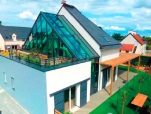Multi-comfortable House of Saint- Gobain: Modern Concept of Comfort in Architecture

The typical feature of modern times is acceleration of pace of scientific and technological advance, increase of worldwide population, globalization and connected to these factors rising pressure on environment. By the intense beat of life a man makes higher demands to the space of inhabitation, and first of all, to the own living space.
Tracing the dynamics of change of a man’s demands during several centuries, it is possible to say confidently that today the notion of comfortable living environment has undergone significant changes: it concerns not only expansion of living area shared by one person but also infrastructure, technical equipment and quality of materials, which a house is made of.
In traditional interpretation comfort is amenity: good organization and a cosy atmosphere of a house, community offices, means of utility lines, and etc. In a figurative sense the notion of emotional comfort is considered as a state of the inner peace, lack of discord with yourself and the surrounding world. Unfortunately, the usual urban environment has density which is inconceivable for natural population (picture 3). But due to achievements in science and technology, it can be a bit expanded. These borders are not identified exactly and as a result the ecological advancement is becoming worse and political and social tension is increasing.
Dynamic lifestyle and intense migration of population require elaboration of different types of dwelling, which meets new demands and principles of the resource-saving. Such an advanced notion of extremality in architecture has already got worldwide acknowledgment.
In order to reach a comfort balance between environment and an inhabitant “Saint-Gobain” company together with Institute of a passive house, Darmstadt (Germany), has elaborated the concept of Multicomfortable house, the peculiarity of which is a positive influence on all canals of perception: eyesight, hearing, sense of smell, sense of touch, intellect (spatial and social adaptation). It includes the following parts:
- thermal comfort – it implies the balance between the temperature of a man’s body and the inner climate of a building;
- sanitary comfort – it is a creation of healthy environment of life activity in conditions of a full physical, mental and social welfare;
- acoustic comfort – it includes a soundproof protection from noise (inner and outer) and architectural acoustics (improvement of speech intelligibility in a room);
- visual comfort – sensation of both physiological and psychological comfort conjugated with interconnection of inner and outer space with a sufficient quantity of natural lighting;
- adaptive comfort – modularity of property, a possibility of a building to adapt to a life cycle of its inhabitants and also to the changes.
Full version you can download here
 Text: Na talia Tima ntseva, PhD in Architecture
Text: Na talia Tima ntseva, PhD in Architecture


